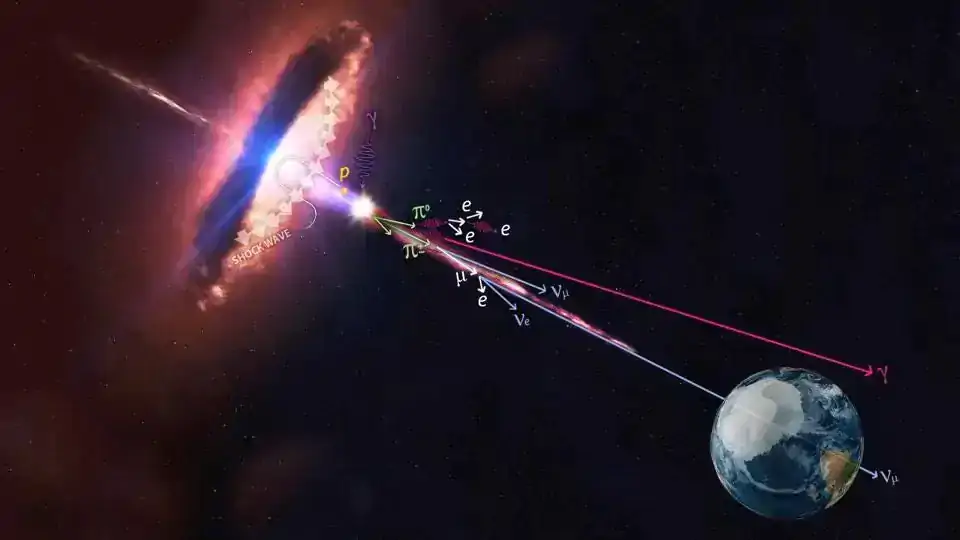One of the most profoundly remarkable properties about our atmosphere is that it’s transparent to not only sunlight, but to starlight as well. As we turn our eyes skyward after the Sun goes down, a glittering tapestry of planets, stars, galaxies, and nebulae illuminates the heavens. If we want to view it, all we have to do is look with the proper tools.
But our view of what’s out there, from here on Earth, is limited in ways we rarely think about. Even on a cloudless night, any light coming to us from space must pass through over 100 kilometers (more than 60 miles) of atmosphere, which itself has continuous variations in density, temperature, and molecular composition. Any light coming in has to contend with the atmosphere, and even though the atmosphere is transparent, that light inevitably gets distorted.
For the first time, astronomers are finally capable of overcoming Earth’s atmosphere. Here’s how.
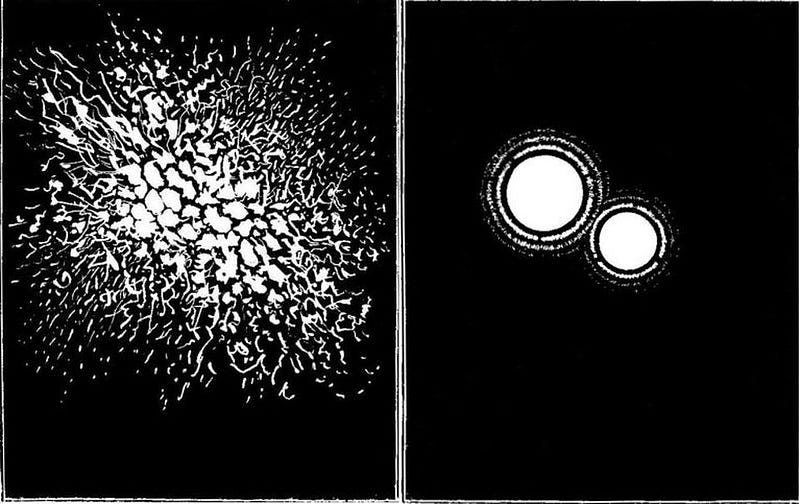
The best way to view the Universe is with the largest, most powerful, and most accurate telescope you can possibly create. The larger your telescope is, the more wavelengths of light can fit across it, increasing its resolution. Larger telescopes also mean better light-gathering power, enabling you to see fainter objects more quickly and in greater detail. This is the reason why the Astro2020 decadal survey recommended the construction of two new ground-based telescopes of an all-new 30 meter class, and why a short-sighted decision from the National Science Foundation to only build one is one that ought to be reversed and overruled.
Once you have a large-aperture telescope, you have to figure out where to put it to gather the needed data optimally. You want the darkest skies possible, as far away from any and all significant sources of light pollution, including cities, squid fisheries, and even the Moon. You want to build your telescope at the highest altitudes possible in the driest conditions possible, eliminating the effects of clouds and water vapor. And you want your telescope in a location where the airflow above you is smooth and slowly varying: laminar, rather than turbulent, airflow. The three greatest locations in the world for optical astronomy, in order, are:
- the summit of Mauna Kea,
- the top of the Andes mountain range,
- and the summit of La Palma.
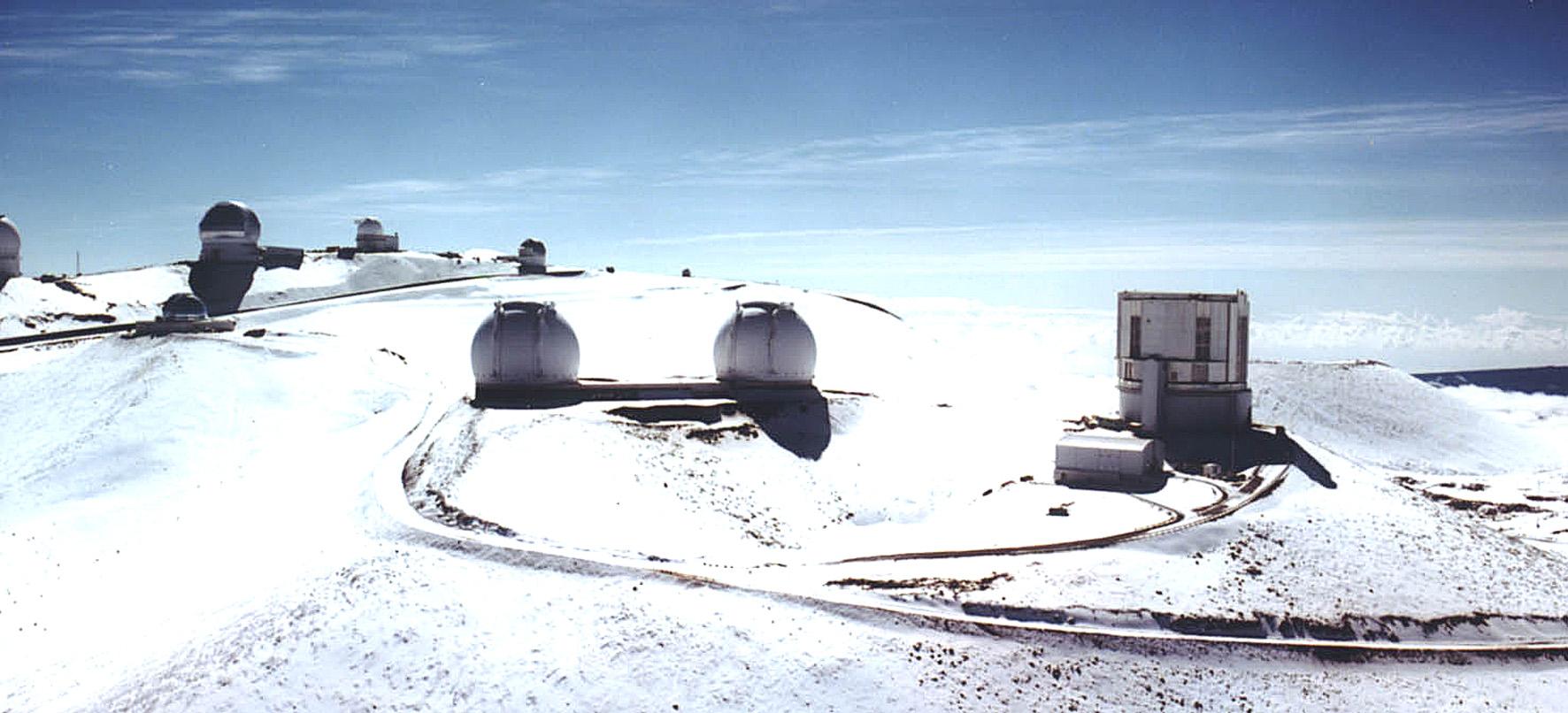
But no matter how high your altitude, you’ll still have Earth’s atmosphere to contend with. The warm air rises, the cool air sinks; the winds blow; the Earth rotates; etc. All of these effects and more cause the molecules of our atmosphere to move and jitter around constantly. Astronomically, every observer must try to find ways to compensate for the trillions upon trillions of molecules interfering with every camera pixel attached to your telescope.
Our atmosphere, no matter how much we attempt to minimize it, is inherently a turbulent entity. The stratified gas layers pass over one another and interact, flowing in a somewhat chaotic, unpredictable fashion from any point of view. It’s fair to say that the lowest atmospheric layers are the densest and the most disruptive to our observations, which is why telescopes are built at such high altitudes and in locations with notoriously still, dry air.
For decades, the only hope of overcoming this was to launch a telescope to space or even aboard a hot air balloon, where it would rise above most of (or all of) our atmosphere. But over the past few decades, a new method has emerged to help address this problem: the use of adaptive optics.
If you look out at an astronomical target and attempt to image it, the atmosphere will severely distort the light along its path from space until it reaches your telescope. But if you know the exact position and brightness properties of even a single object in the sky?—?such as a star?—?there’s a procedure you can follow to compensate for the atmosphere incredibly well. The four steps are as follows:
- Measure the incoming light from an entire narrow field-of-view, including from the known (guide) star.
- Split that light into two beams, using a technology like a beam splitter, where one of those light beams is reflected off of mirrors that force it to take a longer path to the telescope’s instruments, delaying its arrival.
- Use the data from the non-delayed light beam to interact with a surface, which detects how the light from those known (guide) stars has been distorted by Earth’s atmosphere, to compute what shape you’d need a mirror to have in order to “reverse-distort” the light from the guide star back to its original, point-like shape.
- Then create a deformable mirror that takes on that precise shape, reflect all of the delayed, incoming light off of it, and then view the “reverse-distorted” light to obtain as pristine an image of the entire field-of-view that included that guide star (or stars) as possible.
The idea is that when the delayed, reflected light bounces off of that deformable mirror and then gets sent to your instrument’s sensors, you should wind up with as close to a distortion-free image as is possible.

This doesn’t simply involve:
- observing the atmosphere,
- knowing that stars are inherently point-like (from an optical perspective),
- determining what the effect of atmospheric distortion is,
- and then casting a permanent mirror of the right shape to un-distort that light.
If we followed that procedure, our mirror would only accomplish a successful un-distortion when the atmospheric conditions were exactly as they were at the moment we took the data that led us to cast the shape of the mirror.
The reason this process is known as adaptive optics is because we know we can’t just make a one-time adaptation, but rather we have to adapt the atmosphere on a continuous basis. The mirror must constantly adapt to the chaotic changes in the atmosphere in order to compensate for the continuously changing distortion. For a time, we could only use adaptive optics to observe targets that had a known, bright, well-understood star nearby to use as a guide. But as our technology has advanced, we are no longer bound by that restriction.
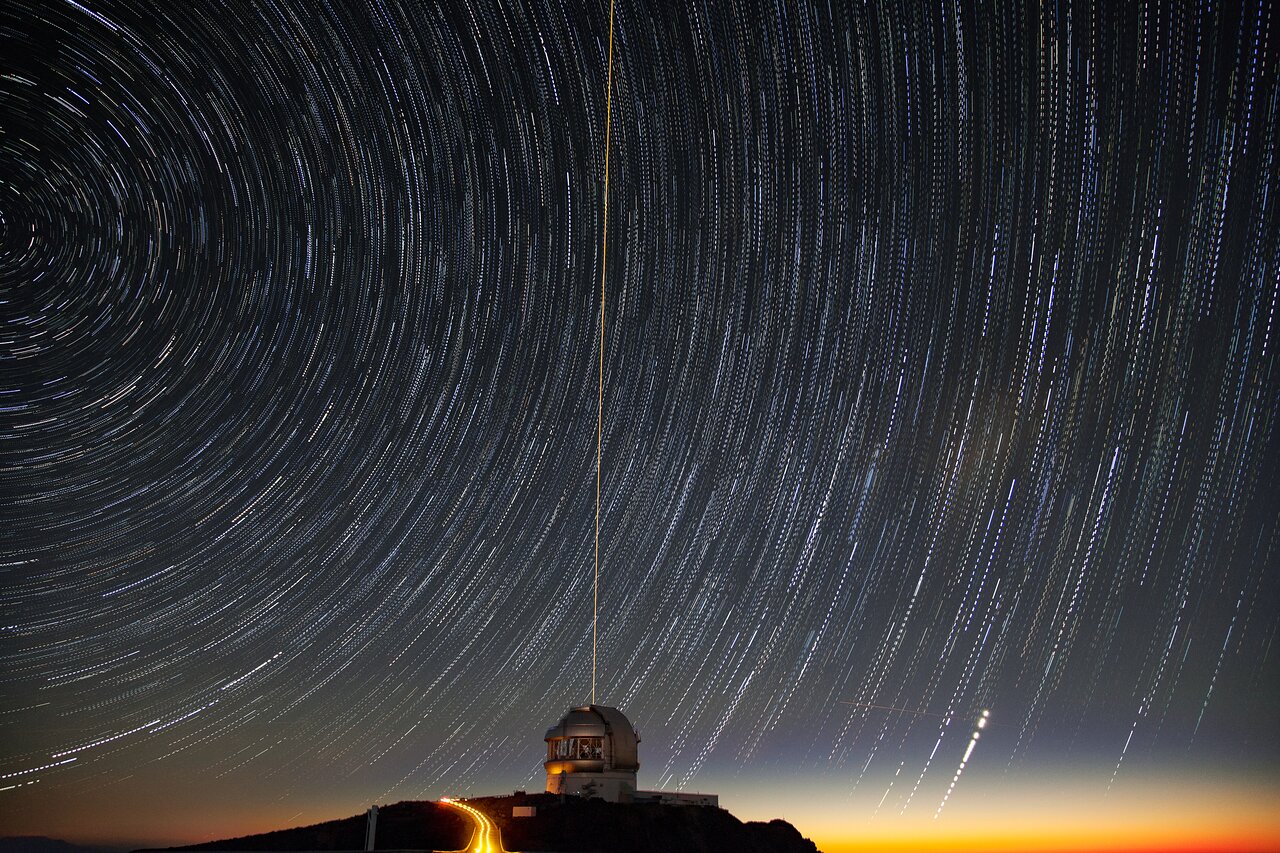
Instead, humanity has developed a spectacular system for adapting to the atmosphere where no bright guide star is present: the creation of an artificial star through the use of sodium lasers. The fact that our atmosphere is layered is crucial to the success of this method. Certain elements are located not all throughout Earth’s atmosphere, but remain narrowly confined in specific layers, where those elements don’t successfully mix with the elements found in other layers. As a result, certain rare elements are found only at very particular altitudes. One of the elements that’s very rare in the atmosphere is sodium, which happens to be concentrated in a very thin layer located about 100 km (60 miles) above Earth’s surface in altitude.
If you fire a sodium laser — that is, a laser that is driven by the absorption and emission features of sodium atoms — into the air, it will travel unperturbed in a straight line (except for the atmospheric distortions), because none of the atoms in the lower atmospheric layers have the right quantum properties to absorb it. The laser light will continue onward until it collides with other sodium atoms: first found in that thin, high layer, where it will be absorbed and send them into an excited state. Those excited atoms then spontaneously de-excite, emitting light in all directions equally, including a fraction of that light back toward your telescope: in the direction your laser came from. This artificial light source, created by ground-based sodium lasers, can now be used as what we call an artificial guide star.
An artificial guide star, as remarkable and useful as it is, remains not quite as good as having a true star to use as a calibration source for determining the needed shape of your adaptive optics mirror. In reality, Earth’s atmosphere continues on, albeit tenuously, so long as Earth’s gravity is important: for hundreds of kilometers (or miles). Even satellites and observatories solidly in low-Earth orbit, up to ~600 km or more above the atmosphere, will eventually fall back to Earth, owing to the drag force provided by these distant atoms and molecules.
But even though the artificial sodium guide star won’t be above 100% of the atmosphere, having a known light source at such a high altitude removes upward of 99% of the distortion. Even from the ground without a true guide star, modern observatories can compete with space-based telescopes in terms of seeing quality, but with much larger telescopes. Compared to Hubble, telescopes like Keck, the VLT, Subaru, Gemini, or the Gran Telescopio Canarias have up to 19 times the light-gathering power, and next-generation telescopes that are going to employ adaptive optics — like the GMT, TMT, and the ELT — will take that superiority into the triple digits: with more than 100 times the light-gathering power of Hubble.

With better light-gathering power and high-enough quality adaptive optics, including a comprehensive real-time knowledge of the field-of-view and a deformable mirror that’s sufficiently successful, ground-based telescopes can match or even outcompete their smaller space-based counterparts. This isn’t just true in theory, but has been practically achieved for more than 10 years now. In 2012, for the first time, the then-most-advanced adaptive optics technology in the world, attached to the Gemini Observatory, was able to outperform the Hubble Space Telescope in a side-by-side comparison where they observed the same field-of-view.
This is showcased by the comparison image below, which shows two images side-by-side:
- ?one taken from the Gemini Observatory, a ground-based 8.19-meter telescope outfitted with cutting-edge adaptive optics on the right?,
- and the other taken with the 2.4-meter Hubble Space Telescope, located more than 500 km up in space and with virtually no atmosphere to contend with on the left.
Even with your own visual tools, your eyes, you may be able to identify, side-by-side, a number of instances where Gemini uncovered stars that Hubble missed.
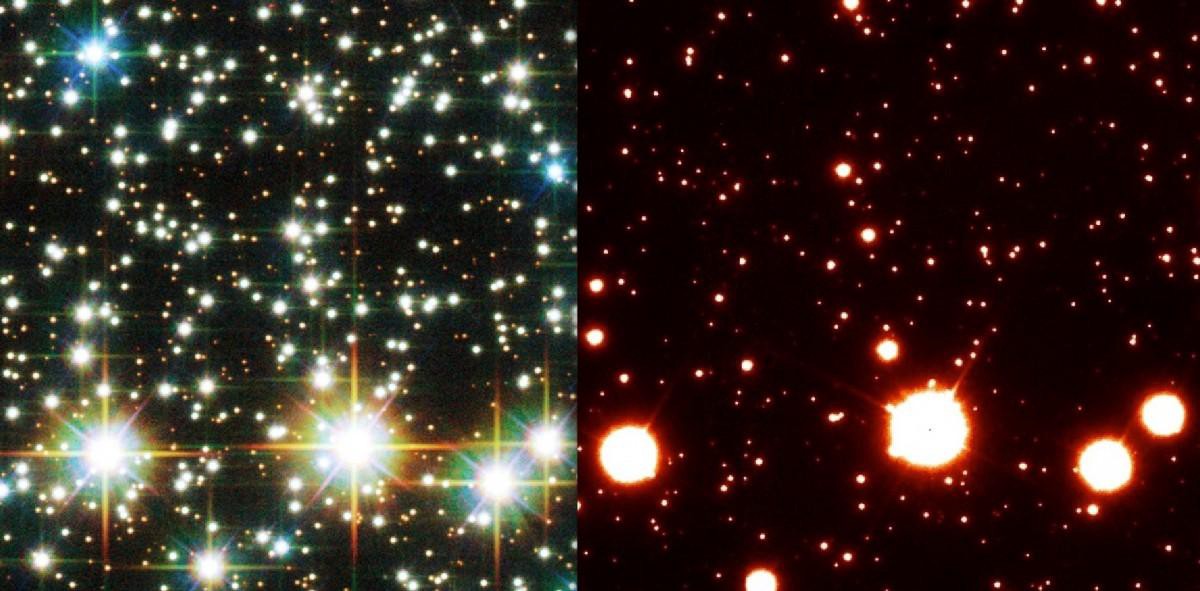
Since that milestone was achieved, astronomers have taken several steps to push the success of adaptive optics into new territory. A single point in the sky can only provide so much information about the atmosphere overall, and going up to 100 kilometers still leaves the highest altitudes — with that last ~1% of the atmosphere’s effects — still unaccounted for. While well-measured natural, bright-enough stars within the field of view are presently the only option for gaining information to compensate for those highest atmospheric altitudes, simply adding additional artificial guide stars across your field of view can vastly improve the quality and utility of your deformable mirror.
The next major advance occurred at Paranal Observatory, which houses the VLT: an array of four 8-meter class telescopes in one of the best observing sites on Earth. Instead of using just one laser, 2016 saw the installation of the most advanced new improvement ever in the field of adaptive optics: the 4 Laser Guide Star Facility (4LGSF). By creating a variety of artificial guide stars across the field-of-view of the telescope, deformable mirrors can compensate for the atmosphere’s distortive effects as never before. Future facilities, such as the ELT, TMT, and GMT, may make use of even greater numbers of lasers, providing a more comprehensive map for the deformable mirrors.
And, as you can see, above, a deformable mirror creates a reflection of an undistorted object that you might describe as akin to what you see from a desert mirage: where the hot ground heats the air around it and causes that heated air to rise in a turbulent fashion. But in this instance, it isn’t turbulence that’s causing this visual effect; it’s the fact that information about the turbulent atmosphere is being passed to the deformable mirror, and that mirror is being continuously deformed in response to compensate for the signal of atmospheric distortion. As you might anticipate, the geometry of the mirror that un-distorts the light has roughly the same effect as the overall distortive effects of the atmosphere itself!
For decades, the only ways to contend with the atmosphere were either to live with it or to go above it. Yet over the past few years, all of that has begun to change. We’ve now entered the era where practically all of the current generation of flagship-class, ground-based observatories have been outfitted with adaptive optics systems akin to the ones outlined here. With the improvements in imaging brought by adaptive optics and the sheer size capabilities of ground-based facilities, the quality of images produced by ground-based astronomy can surpass those of space-based telescopes across a variety of applications. As far as quality imaging-per-dollar goes, ground-based astronomy, equipped with the latest in modern technology, simply can’t be beat by anything we can currently do in space.



 BlocksInform
BlocksInform


